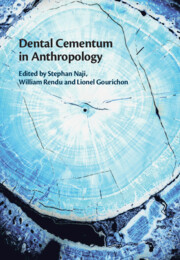Book contents
- Dental Cementum in Anthropology
- Dental Cementum in Anthropology
- Copyright page
- Dedication
- Contents
- Contributors
- Foreword
- Introduction: Cementochronology in Chronobiology
- Part I The Biology of Cementum
- Part II Protocols
- 9 Cementochronology for Archaeologists: Experiments and Testing for an Optimized Thin-Section Preparation Protocol
- 10 Optimizing Preparation Protocols and Microscopy for Cementochronology
- 11 Cementochronology Protocol for Selecting a Region of Interest in Zooarchaeology
- 12 Tooth Cementum Annulations Method for Determining Age at Death Using Modern Deciduous Human Teeth: Challenges and Lessons Learned
- 13 The Analysis of Tooth Cementum for the Histological Determination of Age and Season at Death on Teeth of US Active Duty Military Members
- 14 Preliminary Protocol to Identify Parturitions Lines in Acellular Cementum
- 15 Toward the Nondestructive Imaging of Cementum Annulations Using Synchrotron X-Ray Microtomography
- 16 Noninvasive 3D Methods for the Study of Dental Cementum
- Part III Applications
- Index
- Plate Section (PDF Only)
- References
14 - Preliminary Protocol to Identify Parturitions Lines in Acellular Cementum
from Part II - Protocols
Published online by Cambridge University Press: 20 January 2022
- Dental Cementum in Anthropology
- Dental Cementum in Anthropology
- Copyright page
- Dedication
- Contents
- Contributors
- Foreword
- Introduction: Cementochronology in Chronobiology
- Part I The Biology of Cementum
- Part II Protocols
- 9 Cementochronology for Archaeologists: Experiments and Testing for an Optimized Thin-Section Preparation Protocol
- 10 Optimizing Preparation Protocols and Microscopy for Cementochronology
- 11 Cementochronology Protocol for Selecting a Region of Interest in Zooarchaeology
- 12 Tooth Cementum Annulations Method for Determining Age at Death Using Modern Deciduous Human Teeth: Challenges and Lessons Learned
- 13 The Analysis of Tooth Cementum for the Histological Determination of Age and Season at Death on Teeth of US Active Duty Military Members
- 14 Preliminary Protocol to Identify Parturitions Lines in Acellular Cementum
- 15 Toward the Nondestructive Imaging of Cementum Annulations Using Synchrotron X-Ray Microtomography
- 16 Noninvasive 3D Methods for the Study of Dental Cementum
- Part III Applications
- Index
- Plate Section (PDF Only)
- References
Summary
Dental tissues have the unique property of recording their development history as histological growth markers. Animal studies have shown that many stress events (birth, weaning, infections) can generate a chemical signature. Enamel and dentin offer a retrospective view of significant events occurring in growth but are limited in time to the end of the permanent dentition growth and development. Recent improvements in cementum histological analysis offer new perspectives for analyzing stressors and life history events throughout life. This chapter tests the hypothesis that pregnancy may disrupt acellular cementum (AC) deposits visible in the mineralized matrix, using light microscopy, Raman spectrometry, and scanning electron microscopy equipped with an EDS probe. Two human samples with known age at pregnancies demonstrated that accentuated AC increments can be identified and precisely matched to these events. In both samples, these AC variations were the most outstanding optically and chemically. This is notable since such a method’s ultimate purpose is to identify fertility events in archaeological samples blindly.
- Type
- Chapter
- Information
- Dental Cementum in Anthropology , pp. 234 - 248Publisher: Cambridge University PressPrint publication year: 2022



